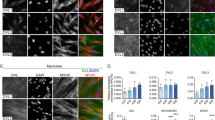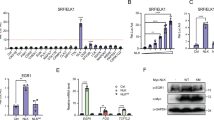Abstract
Select members of the Wnt family of secreted glycoproteins have been implicated in inducing the myogenic determinant genes Pax3, MyoD and Myf5 during mammalian embryogenesis1,2, but the mechanism of induction has not been defined. We describe an unexpected role for protein kinase A (PKA) signalling via CREB in this induction. Using a combination of in vitro explant assays, mutant analysis and gene delivery into mouse embryos cultured ex vivo, we demonstrate that adenylyl cyclase signalling via PKA and its target transcription factor CREB are required for Wnt-directed myogenic gene expression. Wnt proteins can also stimulate CREB-mediated transcription, providing evidence for a Wnt signalling pathway involving PKA and CREB. Our findings raise the possibility that PKA/CREB signalling may also contribute to other Wnt-regulated processes in embryonic patterning, stem cell renewal and cancer3.
This is a preview of subscription content, access via your institution
Access options
Subscribe to this journal
Receive 51 print issues and online access
$199.00 per year
only $3.90 per issue
Buy this article
- Purchase on SpringerLink
- Instant access to full article PDF
Prices may be subject to local taxes which are calculated during checkout





Similar content being viewed by others
References
Tajbakhsh, S. et al. Differential activation of Myf5 and MyoD by different Wnts in explants of mouse paraxial mesoderm and the later activation of myogenesis in the absence of Myf5. Development 125, 4155–4162 (1998)
Fan, C. M., Lee, C. & Tessier-Lavigne, M. A role for WNT proteins in induction of dermomyotome. Dev. Biol. 191, 160–165 (1997)
Moon, R., Bowerman, B., Boutros, M. & Perrimon, N. The promise and perils of Wnt signaling through β-catenin. Science 296, 1644–1646 (2002)
Ordahl, C. (ed.) Somitogenesis Part 2 129–268 (Academic, Toronto, 2000)
Rudnicki, M. et al. MyoD or Myf5 is required for the formation of skeletal muscle. Cell 75, 1351–1359 (1993)
Tajbakhsh, S., Rocancourt, D., Cossu, G. & Buckingham, M. Redefining the genetic hierarchies controlling skeletal myogenesis: Pax3 and Myf5 act upstream of MyoD. Cell 89, 127–138 (1997)
Parr, B., Shea, M., Vassileva, G. & McMahon, A. Mouse Wnt genes exhibit discrete domains of expression in the early embryonic CNS and limb buds. Development 119, 247–261 (1993)
Capdevila, J., Tabin, C. & Johnson, R. Control of dorsoventral somite patterning by Wnt-1 and β-catenin. Dev. Biol. 193, 182–194 (1998)
Barnes, M., Duckworth, D. & Beeley, L. Frizzled proteins constitute a novel family of G protein-coupled receptors, most closely related to the secretin family. Trends Pharmacol. Sci. 19, 399–400 (1998)
Kuhl, M., Sheldahl, L., Park, M., Miller, J. & Moon, R. The Wnt/Ca2+ pathway: a new vertebrate Wnt signaling pathway takes shape. Trends Genet. 16, 279–283 (2000)
Huelsken, J. & Behrens, J. The Wnt signalling pathway. J. Cell Sci. 115, 3977–3978 (2002)
Wang, H. Y. & Malbon, C. Wnt-frizzled signaling to G-protein-coupled effectors. Cell. Mol. Life Sci. 61, 69–75 (2004)
Shaywitz, A. & Greenberg, M. CREB: a stimulus-induced transcription factor activated by a diverse array of extracellular signals. Annu. Rev. Biochem. 68, 821–861 (1999)
Rudolph, D. et al. Impaired fetal T cell development and perinatal lethality in mice lacking the cAMP response element binding protein. Proc. Natl Acad. Sci. USA 95, 4481–4486 (1998)
Ikeya, M. & Takada, S. Wnt signaling from the dorsal neural tube is required for the formation of the medial dermomyotome. Development 125, 4969–4976 (1998)
Ahn, S. et al. A dominant-negative inhibitor of CREB reveals that it is a general mediator of stimulus-dependent transcription of c-fos. Mol. Cell. Biol. 18, 967–977 (1998)
Ott, M., Bober, E., Lyons, G., Arnold, H. & Buckingham, M. Early expression of the myogenic regulatory gene, Myf5, in precursor cells of skeletal muscle in the mouse embryo. Development 111, 1097–1107 (1991)
Bober, E., Franz, T., Arnold, H., Gruss, P. & Tremblay, P. Pax3 is required for the development of limb muscles: a possible role for the migration of dermomyotomal muscle progenitor cells. Development 120, 603–612 (1994)
Munsterberg, A., Kitajewski, J., Bumcrot, D., McMahon, A. & Lassar, A. Combinatorial signaling by Sonic hedgehog and Wnt family members induces myogenic bHLH gene expression in the somite. Genes Dev. 9, 2911–2922 (1995)
Buttitta, L., Tanaka, T., Chen, A., Ko, M. & Fan, C. M. Microarray analysis of somitogenesis reveals novel targets of different WNT signaling pathways in the somitic mesoderm. Dev. Biol. 258, 91–104 (2003)
Mason, J., Kitajewski, J. & Varmus, H. Mutational analysis of mouse Wnt-1 identifies two temperature-sensitive alleles and attributes of Wnt-1 protein essential for transformation of a mammary cell line. Mol. Biol. Cell 3, 521–533 (1992)
Weintraub, H. et al. Activation of muscle-specific genes in pigment, nerve, fat, liver, and fibroblast cell lines by forced expression of MyoD. Proc. Natl Acad. Sci. USA 86, 5434–5438 (1989)
Clegg, C., Correll, L., Cadd, G. & McKnight, G. S. Inhibition of intracellular cAMP-dependent protein kinase using mutant genes of the regulatory type I subunit. J. Biol. Chem. 262, 13111–13119 (1987)
Manning, D. G proteins: Techniques of Analysis (Florida, CRC, 1999)
Iyengar, R. Methods in Enzymology: Heterotrimeric G Proteins Vol. 237 26–37 (Academic, San Diego, 1994)
Epstein, D., Marti, E., Scott, M. & McMahon, A. Antagonizing cAMP-dependent protein kinase A in the dorsal CNS activates a conserved Sonic hedgehog signaling pathway. Development 122, 2885–2894 (1996)
Lonze, B. & Ginty, D. Function and regulation of CREB family transcription factors in the nervous system. Neuron 35, 605–623 (2002)
Buttitta, L., Mo, R., Hui, C. C. & Fan, C. M. Interplays of Gli2 and Gli3 and their requirement in mediating Shh-dependent sclerotome induction. Development 130, 6233–6243 (2003)
Acknowledgements
We thank D. Koshland, Y. Zheng, A. Fire, L. Buttitta and M. Tessier-Lavigne for critical reading of this manuscript and C. Pratt for graphics assistance. D.D.G. is an investigator of the Howard Hughes Medical Institute.
Author information
Authors and Affiliations
Corresponding author
Ethics declarations
Competing interests
The authors declare that they have no competing financial interests.
Supplementary information
Supplementary Figure Legends
Text to accompany the below Supplementary Figures. (RTF 14 kb)
Supplementary Figure S1
Immunohistochemistry on transverse sections through the trunk regions of E9.5 and E10.5 using antibodies against CREB and P-CREB reveals that CREB staining is ubiquitous, whereas P-CREB staining is selective. (PDF 188 kb)
Supplementary Figure S2
CREB-/-S embryos have smaller somites because of a reduction in the rate of cell proliferation, rather than an increase in apoptosis. (PDF 759 kb)
Supplementary Figure S3
Wnt1 and Wnt7a expression is normal in CREB mutants. (PDF 131 kb)
Supplementary Video S4
Gene delivery into mouse embryonic somites through adenovirus infection. Lateral view of E9.75 mouse microinjected with purified adenovirus (labelled with methyl green dye) into the somites on the right side of the body. Timelapse covers a period of approximately 2 minutes. (MOV 606 kb)
Supplementary Figure S5
ACREB adenovirus does not affect expression of Pax1 (marker of developing sclerotome) in injected embryos. (PDF 70 kb)
Supplementary Figure S6
WNT1 and WNT7a induction of CRE-Luc reporter activity in 10T1/2 and C57MG reporter lines is primarily mediated by AC, rather MAPK, PKC, Ca2+ (also known to converge on CREB), or other WNT signalling components, including JNK and canonical effectors. (PDF 21 kb)
Rights and permissions
About this article
Cite this article
Chen, A., Ginty, D. & Fan, CM. Protein kinase A signalling via CREB controls myogenesis induced by Wnt proteins. Nature 433, 317–322 (2005). https://doi.org/10.1038/nature03126
Received:
Accepted:
Published:
Issue Date:
DOI: https://doi.org/10.1038/nature03126
This article is cited by
-
The Wnt-pathway corepressor TLE3 interacts with the histone methyltransferase KMT1A to inhibit differentiation in Rhabdomyosarcoma
Oncogene (2024)
-
Dopamine receptor D4 (DRD4) negatively regulates UCP1- and ATP-dependent thermogenesis in 3T3-L1 adipocytes and C2C12 muscle cells
Pflügers Archiv - European Journal of Physiology (2023)
-
Muscle Stem Cell Function Is Impaired in β2-Adrenoceptor Knockout Mice
Stem Cell Reviews and Reports (2022)
-
Combination of cell signaling molecules can facilitate MYOD1-mediated myogenic transdifferentiation of pig fibroblasts
Journal of Animal Science and Biotechnology (2021)
-
Effects of ginsenosides on bone remodelling for novel drug applications: a review
Chinese Medicine (2020)



